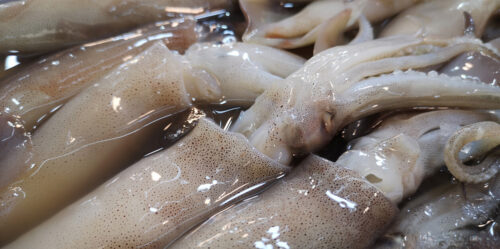The United Nations Sustainable Development Goals (UN SDGs) set ambitious targets to address the global challenges we face, including those related to poverty, hunger, inequality, climate change, environmental degradation and decent work. SDG 14; Life Below Water, will be in the spotlight throughout 2020 as States come together at multiple international meetings to create and drive solutions for a sustainable ocean environment.
 As these milestones unfold, Global Fishing Watch will continue to shine a light on the global footprint of fishing and transshipment, encourage transparency and a focus on rewarding compliant vessels while slowing or halting access to ports for those operating outside of the governance system. We’ll work with relevant governments, research organizations and UN agencies so that this information can support the realization of the SDGs.
As these milestones unfold, Global Fishing Watch will continue to shine a light on the global footprint of fishing and transshipment, encourage transparency and a focus on rewarding compliant vessels while slowing or halting access to ports for those operating outside of the governance system. We’ll work with relevant governments, research organizations and UN agencies so that this information can support the realization of the SDGs.
This blog is the first in a series that will dive into our policy work as it relates to implementation of the SDGs. We’re starting in discussion with Margot Stiles, Program Director at Global Fishing Watch.
How can improved fisheries transparency contribute to the conservation and sustainable use of oceans, seas and marine resources?
A lack of data sharing within and between governments amplifies the inherent lack of awareness of activity at sea, creating the conditions for illegal, unreported and unregulated (IUU) fishing to expand. Sharing information publicly ensures that fishing activity and the exchange of people and goods at sea can’t be as easily hidden. Where data are not shared or individual, proprietary systems are set up, we are creating electronic walls that hamper monitoring and enforcement, yet help illicit operations occur in the blind spots created by this lack of shared awareness.
Global Fishing Watch provides data and analysis to governments which allows more targeted investment of fisheries enforcement resources at sea and in port. We help government agencies monitor marine vessel traffic in a way that is science-based and more cost-effective at the same time. Since the majority of human activity at sea takes place on vessels, tracking this activity is essential to understand how these resources are used and what can be done to improve sustainability.
Transparency in fisheries also makes it possible to ensure fishing operations are compliant with safety and sustainability regulations. For example, when a port inspector checks an arriving vessel, transparency allows them to see the vessel’s history of fishing and previous port visits so they can ask more relevant questions.
With public transparency, we can see where fish are being caught, if there is poaching in marine protected areas and if there are foreign vessels operating in national waters.
What information can be shared to address IUU fishing?
There are three simple steps that States can take to improve fisheries transparency with the support of Global Fishing Watch:
- By sharing fishing vessel registries, we can check that vessels are who they claim to be, and aren’t fraudulently claiming their flag.
- By sharing vessel tracking data, we can highlight behavior that increases risk of IUU having occurred, such as turning off tracking systems and loitering in areas where fishing or transshipment are prohibited.
- By sharing vessel licence lists and authorised transshipments, it is possible to validate a vessel’s claim regarding the provenance of its catch, and it helps protect coastal states against illegal incursions into their waters.
When all three of these are available they can be used to easily piece together a vessel’s activity, and illegal actors and fraudulent claims are quickly identified. Once this data is made available to fisheries officers working in fishing ports around the world, they can implement strong port controls; identify fishing and carrier vessels that appear to have an increased risk of IUU fishing and suggest they are prioritized for inspection while allowing vessels where everything is visible and lines up clearly to unload without delay.
Panama has taken the step to publicly share its VMS data of distant water fishing and carrier vessels. This allows GFW to merge its data with other open data sources and create new insights of who its vessels meet with at sea and allows other organisations the ability to identify instances where Panamanian vessels need investigating for non-compliance. By using this technique, Panama was able to work with its international partners like INTERPOL and Indonesia to arrest and inspect a rogue Panama flagged vessel, the MV NIKA.
How does GFW analysis support the conservation of coastal and marine areas?
Analysis of fishing activity data can help stakeholders generate proposals for new or expanded marine protected areas (MPAs). It can also help governments with the implementation and review of existing MPAs. For example, a recent study using GFW data looked into how a network of MPAs in Europe protects sharks and related species. Researchers determined that there were actually fewer sharks and related animals inside these areas than outside, likely because destructive fishing is still allowed within the protected areas.
Currently, GFW is collaborating with the Galápagos National Park to analyze and compare their land-based tracking data (AIS) with satellite detections which will help improve monitoring of the reserve and fishing by the local fleet. This continuous improvement is key to ensure effective monitoring, control, and surveillance of this sanctuary for the world’s highest abundance of sharks and endemic seabirds, plus the world’s only species of marine iguana.
By providing analysis of fisheries data to our partners that can allow them to implement science-based management plans, inspect and sanction vessels associated with IUU operations, assess the effectiveness of MPAs and maintain designated protected coastal and marine areas, GFW aims to support the realization of SDG 14. However, we cannot do this alone and rely on governments around the world to commit to increasing fisheries transparency to conserve and sustainably use the oceans, seas and marine resources.


